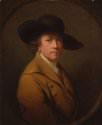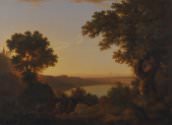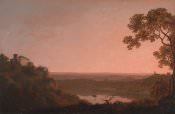Joseph Wright of Derby
Joseph Wright of Derby
Joseph Wright, the son of a clerk, was born in Derby in 1734. His decision to spend the majority of his career in his native city led to his being referred to as “Wright of Derby.” From 1751 to 1753, Wright studied portraiture under Thomas Hudson, who also taught Joshua Reynolds, among others. During the 1760s, in addition to his portraits, Wright produced a series of dramatic nocturnes imbued with the spirit of the Enlightenment, notably A Philosopher lecturing on the Orrery of 1764-66 (Derby Museum and Art Gallery) and An Experiment on a Bird in the Airpump, exhibited at the Society of Artists in 1768.
Wright traveled to Italy in November 1773, accompanied by his pregnant wife and the artists Richard Hurleston and John Downman. They reached Rome in February 1774. There, Wright was stimulated particularly by “the amazing and stupendous remains of antiquity.” He made copious drawings of statuary and classical ruins, as well as landscapes and figure studies. He also studied at the French Academy, the Capitoline Museum, and various palaces. Like Richard Wilson before him, Wright demonstrated in his architectural drawings a curiosity for searching out innovative views and angles, emphasizing the monumentality of structures and the play of strong light and cast shadow. Wright, also like Wilson, was in the habit of making several versions of his drawings, some possibly made after his return to England. Wright left Rome in June 1775, noting subsequently in his journal: “When one has seen Rome, other places suffer by comparison.”
On his return to England, Wright had a brief residence in Bath, where he painted the spectacular Vesuvius in Eruption, the first of numerous compositions based on this theme. By 1777 he had moved back to Derby. In 1781, he was elected an Associate member of the Royal Academy, and a full Academician in 1784—although he declined the honor, due to an argument over the handling of his works. Wright continued to produce portraits, subject pictures and, increasingly, landscapes based on his native Derbyshire and the Lake District. Following a period of ill-heath (he had probably suffered from a stroke), Wright died at age sixty-three in Derby.


